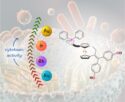Hiroshi Shinokubo, Japan, and his coauthors discovered a simple reductive dimethylation that transforms Ni(II) 5,15-diazaporphyrins into stable, antiaromatic porphyrinoids


Hiroshi Shinokubo, Japan, and his coauthors discovered a simple reductive dimethylation that transforms Ni(II) 5,15-diazaporphyrins into stable, antiaromatic porphyrinoids

Photoactive iron–naphthalene complexes enable fast, environmentally friendly curing of even dark-pigmented alkyd paints

What to read or listen to this summer? I have asked members of the Chemistry Europe community to recommend enjoyable science-themed books and podcasts

First examples of planar tetracoordinate flourine atoms in binary M₄F₄⁻ (M = Li, Na) clusters have been predicted using quantum chemical methods

Max von Delius, Kerstin Leopold, and colleagues developed sulfur-rich network polymers that show excellent metal sorption and battery cathode performance

The EYCN, representing early-career chemists across Europe, and the EIIL, a network of industrial leaders, have partnered to advance leadership development, bridging academia and industry

Supramolecular polymers based on calix[3]acridan allow quick and visible detection of trace benzene vapor with high sensitivity and selectivity.

The modification of ferrociphenol by appending a phosphine moiety to the cyclopentadienyl ring (initially unsubstituted) of the ferrocene unit offers a new and promising approach to enhancing this anticancer agent and enables the synthesis of novel biologically active derivatives.

What insights can we get from a daisy chain structure without a preferential low-energy arrangement of mechanically linked components?

CRISPR-Cas9 was used to edit spider genes, revealing their roles in eye development and enabling fluorescent silk production for the first time.